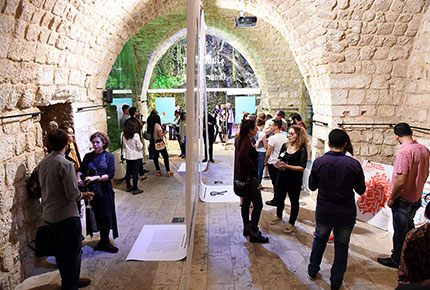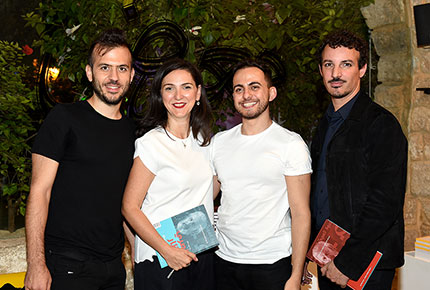The essence of letterforms
LAU brings together internationally acclaimed experts in design, typography and calligraphy to discuss the role of letterforms in the visualization of language.

The event was followed by an exhibition displaying the speakers’ work at the Municipal Cultural Center in the Old Souk of Byblos.

TypeTalks speakers (from left to right): Khajag Apelian, Yara Khoury Naamour, Wael Morcos and Nicolas Ouchenir.
While often overlooked, a typeface has the power to influence the unconscious perception of the target audience. Choosing the right typeface — one able to trigger desired emotions — has increasingly become a priority for corporations seeking an effective marketing strategy.
Letterforms are fundamental elements of communication and the visualization of language. Recognizing the value of this art, LAU’s Department of Design recently organized TypeTalks Byblos 2015, where internationally acclaimed experts shared their thought process, inspiration and professional insight.
According to Melissa Plourde Khoury, associate chair for the Department of Design, this setting was ideal for conversations about letterforms because “this ancient yet modern city is the place where the Phoenician civilization laid the foundation of our alphabets.”
Attending the event was Khajag Apelian, an award-winning speaker hailed for his typographic work that delves into multiple alphabets. “Typography is a medium that is not widely appreciated, but is one of the most important ones,” said Apelian, whose typeface Arek is among the few to include the Armenian language. “To develop new letterforms you have to go back to the roots, to the manuscripts, and study how letters have developed,” he added. To students in the audience who dream of a career in this field he recommended lots of practice and calligraphic exercises.
Wael Morcos, senior designer at Base Design in New York, had a more controversial piece of advice to give. In his speech he argued in favor of copying, seen as a potential catalyst for evolutionary and innovative design outcomes with letterforms. “Calling it ‘copying’ is controversial, as this is something that is frowned upon,” says Morcos, “but when students approach a new project they think of it as a blank page, whereas it is important to research what has been done in the past, copy it and reinvent it.”
Winner of several awards in typography and book design Yara Khoury Nammour presented a behind the scenes glimpse into her research on the unified Arabic alphabet developed by Nasri Khattar, shedding light on Khattar’s methodologies and goals. Paris’s premier calligrapher Nicolas Ouchenir — whose client list includes Louis Vuitton, Hermès, Christian Dior, Gucci, Chloé and Cartier — also took part in the talks, stressing innovation and the necessity of a connection between heart and mind.
More
Latest Stories
- Translation Workshop Widens Students’ Career Horizons
- LAU Engages High Schoolers With Creative Expression and Scholarship Awards
- How Does Digital Media Impact Our Brain?
- Community Development Takes Root at Capstone Presentation Day
- LAU Athletes Return Victorious from Athens and Belgrade
- A New Initiative Toward Harnessing Digital Transformation
- Quality Childcare is the Key to Women’s Empowerment in the Workforce
- A Cardiovascular Conference to Streamline National Expertise

